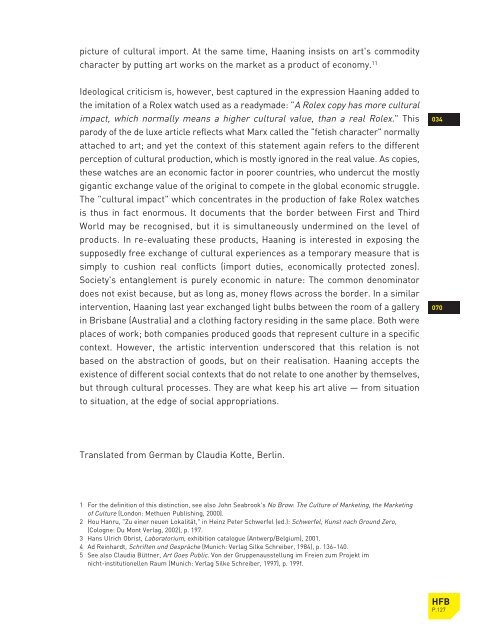download catalogue high resolution pdf (22.3 mb) - Jens Haaning
download catalogue high resolution pdf (22.3 mb) - Jens Haaning
download catalogue high resolution pdf (22.3 mb) - Jens Haaning
Create successful ePaper yourself
Turn your PDF publications into a flip-book with our unique Google optimized e-Paper software.
picture of cultural import. At the same time, <strong>Haaning</strong> insists on art's commodity<br />
character by putting art works on the market as a product of economy. 11<br />
Ideological criticism is, however, best captured in the expression <strong>Haaning</strong> added to<br />
the imitation of a Rolex watch used as a readymade: "A Rolex copy has more cultural<br />
impact, which normally means a <strong>high</strong>er cultural value, than a real Rolex." This<br />
parody of the de luxe article reflects what Marx called the "fetish character" normally<br />
attached to art; and yet the context of this statement again refers to the different<br />
perception of cultural production, which is mostly ignored in the real value. As copies,<br />
these watches are an economic factor in poorer countries, who undercut the mostly<br />
gigantic exchange value of the original to compete in the global economic struggle.<br />
The "cultural impact" which concentrates in the production of fake Rolex watches<br />
is thus in fact enormous. It documents that the border between First and Third<br />
World may be recognised, but it is simultaneously undermined on the level of<br />
products. In re-evaluating these products, <strong>Haaning</strong> is interested in exposing the<br />
supposedly free exchange of cultural experiences as a temporary measure that is<br />
simply to cushion real conflicts (import duties, economically protected zones).<br />
Society's entanglement is purely economic in nature: The common denominator<br />
does not exist because, but as long as, money flows across the border. In a similar<br />
intervention, <strong>Haaning</strong> last year exchanged light bulbs between the room of a gallery<br />
in Brisbane (Australia) and a clothing factory residing in the same place. Both were<br />
places of work; both companies produced goods that represent culture in a specific<br />
context. However, the artistic intervention underscored that this relation is not<br />
based on the abstraction of goods, but on their realisation. <strong>Haaning</strong> accepts the<br />
existence of different social contexts that do not relate to one another by themselves,<br />
but through cultural processes. They are what keep his art alive — from situation<br />
to situation, at the edge of social appropriations.<br />
Translated from German by Claudia Kotte, Berlin.<br />
1 For the definition of this distinction, see also John Seabrook's No Brow: The Culture of Marketing, the Marketing<br />
of Culture (London: Methuen Publishing, 2000).<br />
2 Hou Hanru, "Zu einer neuen Lokalität," in Heinz Peter Schwerfel (ed.): Schwerfel, Kunst nach Ground Zero,<br />
(Cologne: Du Mont Verlag, 2002), p. 197.<br />
3 Hans Ulrich Obrist, Laboratorium, exhibition <strong>catalogue</strong> (Antwerp/Belgium), 2001.<br />
4 Ad Reinhardt, Schriften und Gespräche (Munich: Verlag Silke Schreiber, 1984), p. 136–140.<br />
5 See also Claudia Büttner, Art Goes Public. Von der Gruppenausstellung im Freien zum Projekt im<br />
nicht-institutionellen Raum (Munich: Verlag Silke Schreiber, 1997), p. 199f.<br />
034<br />
070<br />
HFB<br />
P.127


